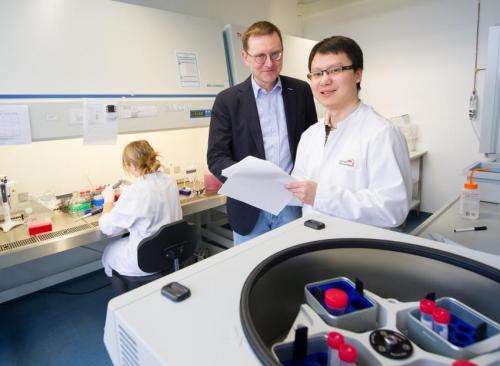Researchers decode a kind of trigger switch for the conversion of fat cells

For a long time, scientists have dreamed of converting undesirable white fat cells into brown fat cells and thus simply have excess pounds melt away. Researchers at the University of Bonn have now gotten a step closer to this goal: They decoded a "toggle switch" in mice which can significantly stimulate fat burning. The results are now being presented in the scientific journal Nature Communications.
Many people not only in industrialized nations struggle with excess weight - but all fat is not alike. "Love handles" in particular contain troublesome white fat cells which store excess food. Brown fat cells are the exact opposite: they burn excess energy as the desirable "heaters" of the body. Scientists at the University of Bonn working with Prof. Dr. Alexander Pfeifer, Director of the Institute for Pharmacology and Toxicology, have spent years using animal models to explore how the undesirable white fat can be converted into sought-after brown fat. "In this way, excess pounds may be able to simply be melted away and obesity combated", says Prof. Pfeifer.
A kind of "trigger switch" spurs fat burning
The researchers have now decoded a "microRNA switch" in mice which is important for brown fat cells. Micro-RNAs are located in the genome of cells and very quickly and efficiently regulate gene activity. The researchers studied a specific microRNA: microRNA 155. The gene regulator micro-RNA 155 inhibits a certain transcription factor, that controls brown fat cell function. Surprisingly, Prof. Pfeifer and his team found that the transcription factor also regulates the levels microRNA 155 establishing a tight feed-back loop that works like a toggle switch: When the microRNA is highly expressed brown fat cell differentiation is blocked; conversely, if the transcription factor wins the upper hand, brown fat is produced at an increased level and this in turn boosts fat burning in the body.
In knockout mice, the gene for Micro-RNA 155 was silent
The researchers at Bonn University and their colleagues from the Federal Institute of Drugs and Medical Devices (BfArM) and from the University of Regensburg worked with so-called transgenic and knockout mice in whom the gene for micro-RNA 155 was either increased or silenced. "The mechanism was already set in motion when the micro-RNA 155 was only halved in the mice," reports lead author Yong Chen, graduate student of the NRW International Graduate School BIOTECH-PHARMA. The mice then had significantly more brown fat cells available than did the control gro up - and had even converted white fat cells into brown fat cells.
Clues to the causes of lipid metabolism diseases
The micro-RNA functions as an antagonist to the brown fat cells. "As long as enough micro-RNA 155 is present, the production of brown fat cells is blocked," says Chen. Only if it falls below a certain proportion does this brake let up; the blueprint for brown fat can be read and implemented by the cell - the desired fat burners can develop. These findings help scientists better understand the causes of lipid metabolism diseases.
Hope for new therapies against obesity
The scientists at the University of Bonn see in their results a potential starting point for drugs to combat obesity. The researchers have clues to the fact that the results, if anything, can be transferred from mice to humans. Thus, for example, researchers in Leipzig found increased levels of micro-RNA 155 in significantly overweight patients. This corresponds to findings from animal models: A lot of micro-RNA 155 is associated with reduced fat burning. "However, we are still in the basic research stage," says Prof. Pfeifer. The path to suitable drugs is still a long one.
More information: miR-155 regulates differentiation of brown and beige adipocytes via a bistable circuit, Nature Communications, DOI: 10.1038/ncomms2742















